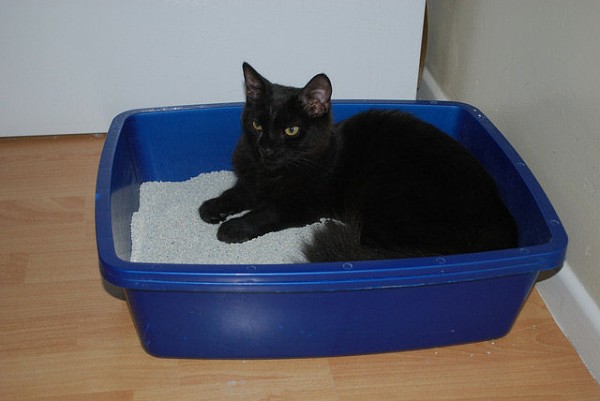
Caring for your cat's litter box is an essential part of proper cat care. Photo credit: wolfsavard/Flickr.com
Caring for your cat’s litter box may not be the most glamorous job in the world but it is absolutely essential if you want your cat to continue using the box regularly. Proper care includes choosing the best cat litter for your cat, regularly cleaning the box, placing the box in the correct location, and more.
Choosing the Best Cat Litter
There are several different types of cat litter and many different brands from which to choose. Clay litters are still the most popular type of cat litter. These litters may be clumping or non-clumping. Clumping litters, as the name suggests, form a nice tight clump of litter when the litter gets wet, making scooping cat urine out of the box an easier project.
In addition to clay litters, there are also silica based crystals which are absorbent and work to soak up cat urine through their porous structure. There are also other “natural” types of litter which are made from biodegradable substances such as recycled newspaper or wheat.
When determining which litter is best for your cat, avoid heavily scented litters. These fragrances are included for our benefit but many cats object to the scents and may avoid the litter box if the scent is too strong. Cat litters with charcoal or baking soda to absorb odors are more likely to be accepted by your cat.
In general, most cats seem to prefer the clumping (or scoopable) type of cat litter. However, the best litter for your cat is the one your cat likes best. Some cats have very definite preferences.
Cleaning the Litter Box
Cleaning the litter box regularly is important. A dirty litter box will put off many cats and your cat may decide not to use the box if it is not clean. Clumping cat litter makes it easy to scoop out urine and feces regularly. Ideally, this should be done at least daily. In multi-cat households, more frequent scooping may be necessary.
The entire litter box should be emptied, cleaned thoroughly and filled with fresh litter at least once monthly. Those litter boxes using non-scoopable litter should be emptied and cleaned at least weekly.
Other Litter Box Considerations
There are a few other things to consider in regards to your cat’s litter box also.
- Be sure you have enough litter boxes. In a multi-cat household, multiple litter boxes are necessary; at least one litter box for each cat plus one additional.
- Be sure the litter box is large enough to accommodate your cat. For most cats, bigger litter boxes are better than smaller.
- Be sure your cat can get in and out of the litter box without difficulty. This can become an issue for very young kittens and for senior cats with mobility issues. Choosing a litter box with low sides may be necessary for these cats.
- Similarly, make sure your cat is not hampered in getting to the litter box and that the litter box is placed in an area where your cat will not be disturbed, frightened or harassed when in the box. Laundry rooms with noisy washers and dryers, for instance, are not an ideal location for the litter box.
- Don’t place your cat’s litter box near the food and water stations. You wouldn’t want to eat in your bathroom. Your cat doesn’t either.
- Hoods on litter boxes tend to trap odors and can make it unpleasant for your cat to use the box. Some cats like the privacy that a hood provides but most prefer an open uncovered litter box.
If your cat’s litter box habits suddenly change, have your cat examined by your veterinarian. Though often litter box issues are behavioral in nature, medical issues can be responsible as well.




